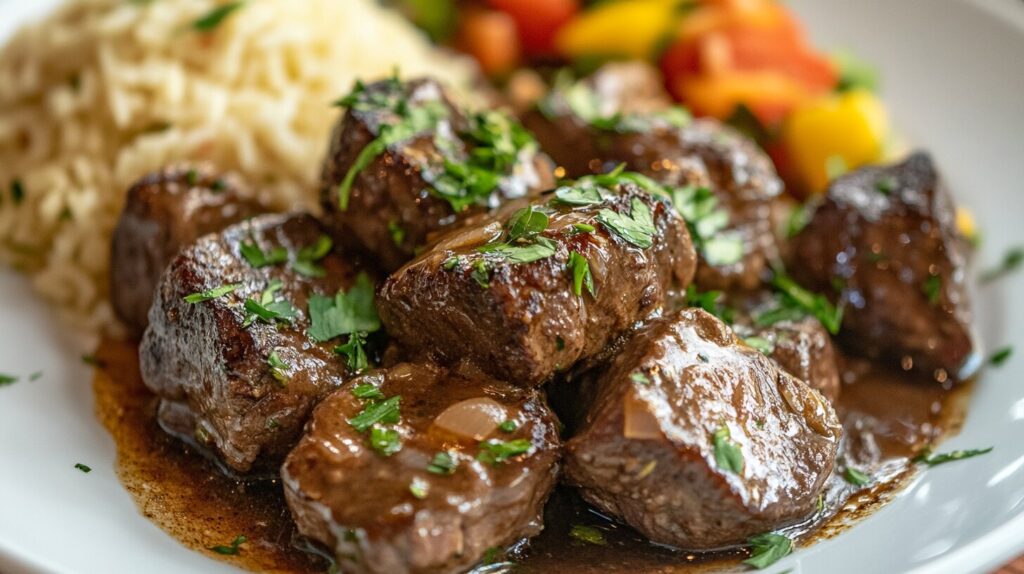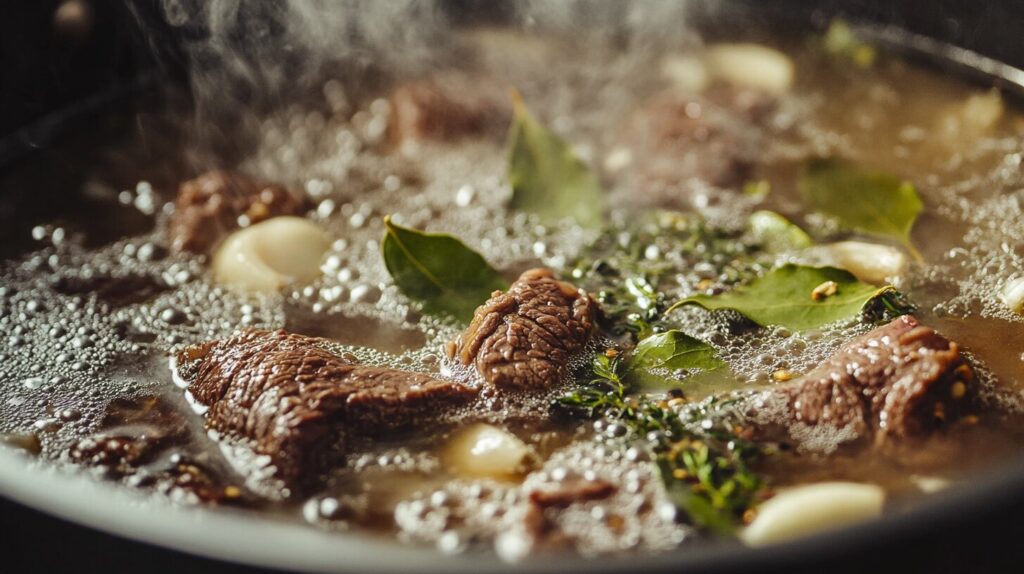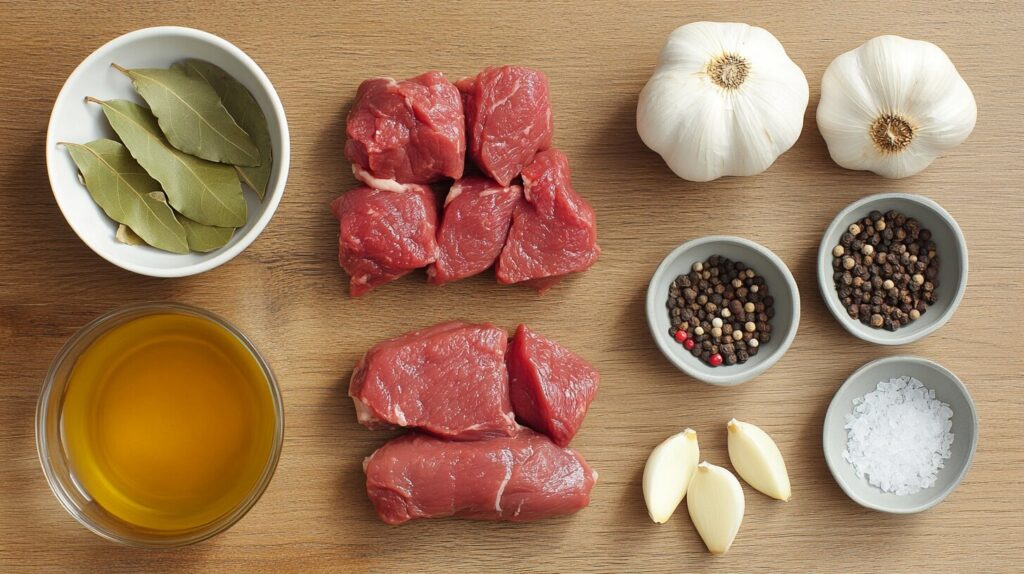
Table of Contents
Beef tips are small, cubed pieces of beef cut from tougher parts like the chuck or round. To learn more about the different cuts and their uses, check out our guide on Understanding Beef Tips: A Comprehensive Beef Tips Guide. These cuts are versatile and work well in stews, stir-fries, and casseroles. If you want boiling beef tips tender, the cut you choose is crucial. Some butchers may offer tender cuts; however, budget options usually come from tougher sections. Because beef tips are small, they cook faster than large cuts. As a result, they are perfect for quick meals or slow-cooked dishes. With the right preparation, even tough beef tips can become tender and flavorful through boiling.
Why Is Tenderness Important in Beef?
Tender beef is easier to chew and more enjoyable to eat. Moreover, boiling beef tips tender adds a satisfying texture to meals. Tough meat, on the other hand, can ruin an otherwise delicious dish. Tender meat results from breaking down muscle fibers and connective tissue. This happens with the right cooking techniques. Additionally, tender beef absorbs flavors better, making it ideal for saucy recipes. Cooking time, temperature, and the cut of meat all influence tenderness. Ultimately, mastering these factors helps you achieve perfectly tender beef tips.
What Does Boiling Do to Meat?
The Science of Boiling Meat
Boiling beef tips tender works by submerging the meat in hot water between 180°F and 212°F. This method breaks down collagen in tough cuts of beef. As the water heats the meat, the collagen turns into gelatin, making the meat tender. Additionally, boiling helps retain moisture better than dry-heat methods like roasting. However, boiling can cause nutrients and flavors to leach into the water. Therefore, adding herbs and spices to the water is essential. Ultimately, understanding this process helps you use boiling effectively.

How Heat and Moisture Affect Beef Texture
Heat and moisture play key roles in meat texture. Heat causes muscle proteins to firm up. Meanwhile, moisture helps keep the meat juicy during cooking, which is key to achieving boiling beef tips tender results. However, if the heat is too high, the fibers contract and squeeze out moisture. This makes the meat tough. In contrast, cooking at a low, steady temperature allows the connective tissue to break down gently. As a result, the beef becomes tender. Therefore, moist-heat methods like boiling balance heat and moisture well. By controlling these factors, you can ensure perfectly tender beef tips.
Benefits of Boiling Beef Tips
How Boiling Helps Break Down Tough Fibers
Boiling beef tips tender is a great method for breaking down tough fibers. Tough cuts have lots of collagen, making them chewy. Fortunately, boiling breaks this collagen down into gelatin. This process takes time, but a slow boil works better than a rapid one. Additionally, boiling allows flavors from herbs, spices, and broth to infuse into the meat. Therefore, with the right technique, you can turn tough beef tips into a tender and flavorful dish.
Adding Flavor During Boiling
Boiling beef tips tender doesn’t have to mean bland results. For instance, adding herbs, spices, and vegetables to the boiling liquid enhances flavor. Good options include onions, garlic, bay leaves, and peppercorns. Moreover, using broth or stock instead of water can add depth. Additionally, a splash of wine or vinegar brings acidity and complexity. After boiling, the liquid can be used as a sauce or gravy. Ultimately, these simple steps ensure your beef tips are both tasty and tender.

Drawbacks of Boiling Beef Tips
Risk of Overcooking and Toughening Meat
Boiling beef tips too long or at high heat can make them tough. Learn how to avoid this by understanding What Makes Round Steak Tender? The muscle fibers contract and squeeze out moisture. Consequently, this leaves the meat dry and chewy. To avoid this, use a gentle simmer instead of a rolling boil. Additionally, check the meat periodically for tenderness. A fork should slide in easily when it’s done. Therefore, patience and careful timing are key to achieving tender beef tips.
Loss of Nutrients and Flavor in Boiling Liquid
One downside to boiling is the loss of nutrients and flavor into the liquid. For example, vitamins and minerals leach out during cooking. As a result, the meat may lose some of its natural taste. However, you can reclaim these nutrients by using the boiling liquid for sauces or soups. Additionally, adding vegetables and herbs boosts the flavor. Therefore, using broth instead of water helps maintain a rich and savory profile. This way, you maximize both nutrition and taste.
How to Boil Beef Tips for Maximum Tenderness
Choosing the Right Cut of Beef
Selecting the right cut of beef is crucial for tender results. Specifically, tougher cuts like chuck, round, or brisket work best. These cuts contain connective tissue that breaks down during boiling. In contrast, leaner cuts like sirloin lack this collagen. Therefore, they don’t become as tender when boiled. When shopping, ask for “stew meat” or beef tips from chuck or round. Ultimately, choosing the right cut ensures you get tender and flavorful results.
Step-by-Step Boiling Instructions
To achieve boiling beef tips tender, follow these steps. First, season the beef tips with salt and pepper. Next, brown them in a pot with a bit of oil for added flavor. Then, add enough water or broth to fully cover the meat. Bring the liquid to a boil, then reduce to a simmer. After that, cover the pot and let it cook for 1.5 to 2 hours. Meanwhile, check the liquid level periodically and add more if needed. Finally, test for tenderness with a fork. The meat should be easy to pierce. At this point, you can use the remaining liquid for a sauce or gravy.
Enhancing the Flavor of Boiled Beef Tips
Best Spices and Herbs to Use
Herbs and spices can transform boiled beef tips. For example, bay leaves, thyme, rosemary, and peppercorns add depth. Additionally, garlic and onions are classic choices. If you prefer a bit of heat, add paprika or chili powder. Furthermore, fresh herbs like parsley or cilantro can brighten the dish. Ultimately, experimenting with different seasonings helps you find the perfect flavor.
Adding Vegetables for Depth of Flavor
Vegetables can significantly enhance the flavor of boiled beef tips. For instance, carrots, celery, and onions add natural sweetness. Additionally, potatoes provide heartiness to the dish. During boiling, these vegetables soak up the meat’s flavor. As a result, the dish becomes richer and more satisfying. After boiling, you can mash the vegetables into the sauce for a thicker texture. Therefore, adding veggies is a simple way to elevate your dish.
Alternative Cooking Methods for Tender Beef Tips
Slow Cooking and Braising
Slow cooking and braising are excellent alternatives to boiling. In fact, both methods use low heat over a long period to break down tough muscle fibers. For instance, in slow cooking, you can combine beef tips with broth, vegetables, and seasonings. Then, let them cook on low for 6 to 8 hours. As a result, you’ll get incredibly tender, flavorful meat with minimal effort. On the other hand, braising involves searing the beef tips first to develop a rich, caramelized crust. Afterward, you cook the meat in a covered pot with just enough liquid to partially cover it. Ultimately, the combination of steam and simmering liquid ensures a tender result. Therefore, both slow cooking and braising offer consistent, foolproof ways to achieve deliciously tender beef tips.
Searing and Simmering Techniques
Searing and simmering combine the best of dry and moist heat. To begin with, heat a pan with oil and sear the beef tips until they’re brown on all sides. This step creates a rich, caramelized flavor. Next, add broth, wine, or a sauce to the pan, making sure to scrape up any browned bits. Then, reduce the heat to low, cover the pan, and let it simmer for 1 to 2 hours. Consequently, the slow simmering tenderizes the meat while infusing it with flavor. Furthermore, this method works well for dishes like beef stroganoff or beef tips with gravy. In summary, searing locks in the juices, and simmering makes the meat tender and flavorful.
Boiling vs. Braising: Which Is Better?
Comparing Moist Heat Cooking Methods
Boiling and braising are both effective moist heat cooking methods. However, they have distinct differences that affect the final dish. Boiling fully submerges the meat in liquid and cooks it at a higher temperature. As a result, it works well for soups, stews, and dishes that need plenty of liquid. In contrast, braising uses less liquid and a lower temperature. The meat is only partially submerged, allowing steam to tenderize the beef while the liquid reduces. Therefore, braising typically results in a richer, more concentrated flavor. Ultimately, while boiling is quicker and simpler, braising offers more control over flavor and texture. Thus, the choice depends on your desired outcome and the type of dish you’re preparing.
When to Choose Boiling Over Braising
Boiling is ideal for recipes that require a lot of liquid, like soups or stews. Additionally, it’s perfect when cooking large batches of beef tips because it ensures even cooking. Furthermore, boiling is simple and efficient, making it a great option for busy cooks. On the other hand, braising is better when you want a thicker, richer sauce. For example, dishes like beef tips in gravy or wine sauce benefit from braising. Ultimately, choose boiling for simplicity and efficiency, and braising for flavor complexity and texture. In short, understanding the strengths of each method will help you make the right choice.
Common Mistakes When Boiling Beef Tips
Boiling Too Quickly
A frequent mistake when trying to achieve boiling beef tips tender is boiling them too quickly. Unfortunately, high heat causes the muscle fibers to tighten, which squeezes out moisture. As a result, the meat becomes tough and chewy. Instead, use a gentle simmer to break down the connective tissue gradually. In this way, you can achieve tender and juicy beef tips. Therefore, patience and a steady cooking temperature are essential for success.
Not Using Enough Seasoning
Another common mistake is under-seasoning the beef tips. Because boiling can draw out some of the meat’s natural flavor, proper seasoning is crucial. For instance, adding salt, pepper, garlic, and herbs can enhance the overall taste. Additionally, using broth or stock instead of plain water adds richness. As a result, your boiled beef tips will be flavorful and satisfying. Ultimately, seasoning well from the start ensures a delicious dish.
Ignoring the Quality of the Beef
The quality of the beef you choose matters significantly. For example, cheaper cuts might take longer to tenderize. Therefore, selecting the right cut, such as chuck or round, is essential for good results. In addition, avoid cuts that are too lean, as they don’t respond well to boiling. Ultimately, high-quality cuts lead to better texture and taste. By choosing wisely, you set yourself up for success.
Cooking for Too Long or Too Short a Time
Timing is everything when boiling beef tips. If you boil for too long, the meat can become dry and stringy. On the other hand, if you don’t boil long enough, the meat remains tough and chewy. Therefore, aim for a cooking time of 1.5 to 2 hours. Meanwhile, check the beef tips occasionally for tenderness. When a fork slides in easily, the meat is ready. In summary, finding the right balance of time ensures tender, delicious beef tips.
Enhancing the Flavor of Boiled Beef Tips
Best Spices and Herbs to Use
Spices and herbs can elevate the flavor of boiling beef tips tender. For example, bay leaves, thyme, and rosemary add depth. Additionally, garlic and onions are classic options that enhance the meat’s savory taste. If you prefer more heat, try adding paprika or chili powder. Moreover, fresh herbs like parsley can brighten the dish at the end. Ultimately, using the right seasonings ensures your beef tips are flavorful and enjoyable.
Adding Vegetables for Depth of Flavor
Vegetables add complexity and richness to boiled beef tips. For instance, carrots, onions, and celery release natural sweetness during cooking. Furthermore, potatoes can add heartiness to the dish. As they cook, these vegetables absorb the meat’s flavors. Consequently, they make the dish more satisfying. After boiling, you can blend the vegetables into the sauce for added texture. Therefore, adding vegetables is a simple way to enhance both flavor and nutrition.
Using Broths and Stocks for Richer Taste
Replacing water with broth or stock is an easy way to boost flavor. For instance, beef stock adds a deep, savory taste, while chicken broth provides a lighter option. Additionally, a splash of wine or soy sauce can add complexity. As the beef tips cook, the broth infuses them with flavor. In the end, the remaining liquid can be reduced to create a tasty sauce or gravy. Therefore, using broth ensures your beef tips are rich and satisfying.
Marinating Before Boiling for Extra Tenderness
Marinating beef tips before boiling adds both tenderness and flavor. For example, a marinade with vinegar or lemon juice helps break down tough fibers. Additionally, herbs, garlic, and spices enhance the meat’s taste. Let the beef marinate for at least an hour, or overnight for best results. As a result, the flavors penetrate deeply, and the meat becomes more tender. Ultimately, marinating is a simple step that makes a big difference.
How to Tell If Your Beef Tips Are Tender
Visual and Texture Indicators
Determining if your beef tips are tender can be done by observing visual and texture cues. For example, tender beef tips should look slightly swollen and moist. In addition, they should appear darker because of the cooking process. When touched, the meat should feel soft and easy to separate. If the meat feels firm and doesn’t yield easily, it likely needs more cooking time. Therefore, keep simmering until the beef reaches the right texture. By paying attention to these signs, you can confidently decide when your beef tips are ready to enjoy.
Using a Fork Test to Check Tenderness
The fork test is one of the simplest ways to check tenderness. First, insert a fork into a piece of beef. If it slides in easily and the meat starts to fall apart, it’s tender and ready to serve. However, if there is resistance and the meat doesn’t separate, it needs more time to cook. Additionally, try twisting the fork gently. If the beef shreds without effort, the texture is perfect. On the other hand, if the meat holds its shape, continue simmering. Ultimately, the fork test helps you avoid undercooked or overcooked beef tips.
The Role of Resting the Meat
Resting the beef tips after boiling is essential for the best texture. Once cooking is done, remove the beef tips from the liquid and let them rest for 5 to 10 minutes. During this time, the juices redistribute throughout the meat, ensuring a moist and tender bite. Furthermore, resting helps the meat firm up slightly, making it easier to serve. If you skip this step, the juices may spill out when you cut into the meat, leaving it dry. Therefore, always allow a few minutes of resting time for the best results. In conclusion, resting enhances tenderness and juiciness.
Nutritional Value of Boiled Beef Tips
How Boiling Affects Nutrient Retention
Boiling beef tips can affect nutrient content. For instance, water-soluble vitamins like B vitamins may leach into the boiling liquid. However, these nutrients are not lost entirely. Instead, they remain in the cooking broth, which can be used in sauces or soups. Additionally, boiling preserves protein content, making beef tips a good source of protein. On the other hand, boiling for too long can reduce the nutrient density. Therefore, using the broth helps reclaim nutrients and enhance your dish’s nutritional value. In summary, boiling impacts nutrients, but careful cooking minimizes these losses.
Calories and Protein Content
Boiled beef tips are a great source of protein, which is essential for muscle repair and growth. Typically, a 3-ounce serving contains about 25 grams of protein. Additionally, this portion provides around 200 to 250 calories, depending on the cut and fat content. However, trimming excess fat before cooking can lower the calorie count. Furthermore, boiling allows some fat to render out into the cooking liquid, making the meat leaner. As a result, boiled beef tips are a healthy, protein-rich option. Ultimately, they provide energy and essential nutrients for a balanced diet.
Balancing Tenderness and Nutrition
Balancing tenderness and nutrition is achievable with the right cooking techniques. For example, choosing tougher cuts like chuck ensures you get both tenderness and flavor. Meanwhile, boiling gently over low heat helps preserve the meat’s nutrients. Additionally, using the broth in your dish helps you recover any lost vitamins. If you want to add more nutrition, include vegetables like carrots, onions, and celery. In this way, your meal becomes more balanced and flavorful. Ultimately, boiling beef tips properly can give you a dish that is both nutritious and tender.
Best Recipes Using Boiled Beef Tips
Classic Beef Stew Recipe
A classic beef stew is one of the best ways to use boiled beef tips. To begin with, brown the beef tips in a pot to enhance flavor. Next, add onions, garlic, carrots, and potatoes for heartiness. Pour in beef broth and season with herbs like thyme and bay leaves. Then, let the stew simmer gently for 2 hours until the beef is tender. Finally, serve hot with crusty bread or rice. This method ensures a comforting, flavorful dish. Therefore, classic beef stew is perfect for cold days and satisfying meals.
Boiled Beef Tips with Vegetables and Herbs
This simple recipe combines boiled beef tips with healthy vegetables. First, boil the beef tips with garlic, onions, and bay leaves for flavor. After about an hour, add carrots, potatoes, and celery to the pot. Then, season with salt, pepper, and rosemary. Continue cooking until the vegetables are tender. Finally, serve the beef tips and vegetables with a drizzle of the flavorful broth. In summary, this dish is easy, nutritious, and perfect for a wholesome meal.
Beef and Gravy Over Rice
Beef tips with gravy over rice is a comforting, satisfying meal. First, boil the beef tips until they are tender. Next, remove the beef and use the broth to make a gravy by adding flour or cornstarch. Then, season the gravy with salt, pepper, and herbs like thyme. Once the gravy thickens, return the beef to the pot. Finally, serve the beef and gravy over steamed rice. As a result, you get a rich, filling dish that’s easy to prepare. Therefore, this recipe is perfect for a quick, hearty dinner.
Creative Uses for Leftover Boiled Beef Tips
Leftover boiled beef tips can be used in many creative ways. For instance, shred the beef and use it for tacos or burritos. Additionally, add the beef to pasta dishes or stir-fries for a quick protein boost. You can also make a beef sandwich with gravy and melted cheese. Another idea is to use the beef tips in a hearty soup with beans and vegetables. Ultimately, leftovers offer endless possibilities for easy, delicious meals.
FAQs About Boiling Beef Tips
Does Boiling Make All Cuts of Beef Tender?
No, not all cuts respond well to boiling. For example, lean cuts like sirloin can become dry. On the other hand, tougher cuts like chuck or brisket benefit from boiling. Therefore, choose cuts with more connective tissue for the best results.
How Long Should You Boil Beef Tips?
It usually takes 1.5 to 2 hours to boil beef tips until they are tender. However, the exact time depends on the cut and size of the pieces. Check periodically by using a fork to test for tenderness.
Can You Overcook Beef Tips by Boiling?
Yes, overcooking can make beef tips dry and tough. Therefore, simmer gently and avoid high heat. Check regularly to prevent overcooking and achieve the right texture.
What’s the Best Way to Add Flavor When Boiling?
Add herbs, spices, and vegetables to the boiling liquid. Additionally, use broth instead of water for a richer taste. These steps ensure the beef tips are flavorful.
Is Boiling Beef Tips Healthier than Frying?
Yes, boiling is a healthier option because it uses less fat. Furthermore, it allows excess fat to render out. As a result, boiled beef tips are lower in calories compared to fried ones.
Conclusion
Final Thoughts on Boiling Beef Tips for Tenderness
Boiling beef tips is an effective and straightforward way to achieve tenderness. While it may seem simple, the process requires patience and the right techniques. For instance, choosing the correct cut of beef, seasoning well, and boiling at a gentle simmer all contribute to the best results. Furthermore, understanding how boiling affects meat texture helps you avoid common pitfalls like overcooking. On the other hand, alternative methods such as braising or slow cooking also provide great options for tenderizing beef tips. Ultimately, the method you choose depends on the dish you want to create. Therefore, with the right approach, you can transform even the toughest beef tips into a delicious, tender meal. In summary, boiling, when done properly, can be a reliable and flavorful way to prepare beef tips.
